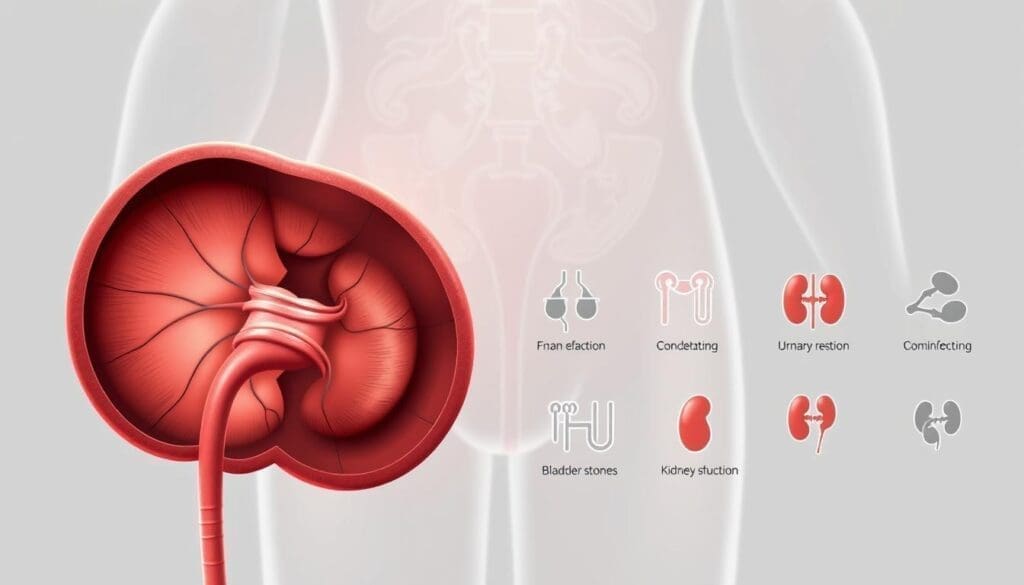Last Updated on November 25, 2025 by Ugurkan Demir

Understanding Benign Prostatic Hyperplasia (BPH)Understand enlarged prostate by exploring BPH etiology and pathophysiology. Get 7 key insights into the causes and development of BPH.
Benign Prostatic Hyperplasia, or BPH, is when the prostate gland gets bigger. It’s common in older men and can really affect their daily life. We’ll explore the reasons, signs, and ways to manage BPH. This will help those dealing with it understand more.

Benign Prostatic Hyperplasia (BPH) affects millions of men globally. The exact cause is not known, but several risk factors have been found.
Age is a big risk factor, with the risk going up after 40. Family history also matters, with a higher risk if a first-degree relative has BPH.
| Risk Factor | Description |
| Age | Increased risk with advancing age |
| Family History | Presence of BPH in first-degree relatives |
| Hormonal Imbalance | Conversion of testosterone to dihydrotestosterone (DHT) |
Knowing these risk factors helps in early detection and management of BPH.

Benign Prostatic Hyperplasia (BPH) is a common condition in men. It causes various urinary symptoms that can be quite bothersome. These symptoms can affect daily life significantly.
One main symptom is a weak or interrupted flow of urine. Men might find their urine stream weaker, making it hard to fully empty their bladder. This can cause frustration and discomfort.
Men with BPH also often need to urinate more frequently. This can be a big problem at night, disrupting sleep. It can really affect a man’s quality of life.
Other symptoms include trouble starting or stopping urination. Men might also need to urinate more often. These symptoms can greatly impact a man’s daily activities and overall well-being.
It’s very important for men with these symptoms to see a healthcare professional. They can get a proper diagnosis and treatment. With the right care, men with BPH can manage their symptoms and improve their quality of life.
We diagnose BPH by looking at symptoms, medical history, and test results.
Diagnosing BPH takes a few steps. First, a doctor will check your symptoms and medical history. This helps them understand how BPH affects your life.
A key part of diagnosing BPH is the prostate examination. This includes a digital rectal examination (DRE). The doctor feels the prostate gland for any problems, like growths or irregularities.
Along with the physical check-up, several tests might be done. These include:
These tests help doctors figure out if you have BPH and how severe it is. They use this info to plan the best treatment for you.
| Diagnostic Test | Purpose |
| Digital Rectal Examination (DRE) | To assess the size and texture of the prostate gland. |
| Prostate-Specific Antigen (PSA) Test | To measure the level of PSA in the blood, which can be elevated in men with BPH or prostate cancer. |
| Urodynamic Tests | To evaluate the flow of urine and the bladder’s ability to empty. |

BPH treatment includes many strategies, from lifestyle changes to medical options. The right treatment depends on how bad the symptoms are, your health, and what you prefer.
Simple lifestyle changes can help a lot with BPH symptoms. These changes are easy to make and can be very effective.
Some research also points to the benefits of certain nutrients and supplements. For example, beta-sitosterol, found in plants, can improve urine flow and reduce symptoms.
| Lifestyle Change | Benefit |
| Dietary Adjustments | Reduces symptoms, improves overall health |
| Fluid Management | Decreases nighttime urination |
| Regular Exercise | Improves urinary flow, overall health |
For many men, these lifestyle changes are enough to manage BPH symptoms well. But if symptoms are severe, medical treatment might be needed.
Doctors often prescribe medications like alpha-blockers and 5-alpha-reductase inhibitors for BPH. These drugs relax the muscles in the prostate and bladder neck, making it easier to urinate. Or they shrink the prostate.
We’ll look at these medical treatments in more detail next. This will give you a full view of how to manage BPH.

Untreated BPH can lead to serious health problems like urinary retention and kidney damage. This shows why it’s important to get medical help early. If BPH is not treated, it can cause many issues that affect the prostate and urinary health.
One big problem is urinary retention. This happens when the prostate gets too big and blocks urine flow. It makes it hard to fully empty the bladder. This can be either short-term or long-term and might need a catheter to fix.
“The risk of urinary retention in men with BPH is significant, and it shows why early treatment is key to avoid these issues.”
Another serious issue is kidney damage. BPH can put too much pressure on the kidneys over time. This can harm the kidneys and make them work poorly. It might even make existing kidney problems worse.
Untreated BPH can also cause other problems like urinary tract infections (UTIs), bladder stones, and blood in the urine. These issues not only make life harder but also show the disease is getting worse.
We stress that knowing about these risks is why you should see a doctor if you have BPH symptoms. Getting help early can stop these problems and help you feel better in the long run.
Living with BPH can be tough, but the right steps can make a big difference. It’s not just about treating symptoms. It’s about feeling better overall.
Managing BPH means making lifestyle adjustments. This includes eating right, staying active, and managing stress. These changes can ease symptoms and boost health.
BPH can really affect a man’s life. Symptoms like needing to pee a lot, weak flow, and waking up to pee can mess up daily life. By adopting a proactive approach to managing BPH, men can fight these issues and stay comfortable and independent.
In summary, managing BPH needs a full plan. This includes medical care, lifestyle changes, and support. By taking charge, men can greatly improve their life and stay active and happy.
Understanding Benign Prostatic Hyperplasia (BPH) is key to managing it well. Its causes and risk factors, like age and hormonal changes, are important. They help us see why BPH happens.
Knowing the symptoms of BPH is vital for early treatment. Symptoms include needing to pee a lot and having a weak urine flow. Healthcare providers can then create a treatment plan that works for each person.
We think men can handle their BPH symptoms better. By knowing more and working with doctors, they can control their condition. This improves their overall health and well-being.
Symptoms of BPH include weak or interrupted urine flow. You might also find yourself urinating more often. Waking up at night to use the bathroom is another sign.
Difficulty starting or stopping urination is common. You might also feel like you’re not fully emptying your bladder.
The exact cause of BPH is not fully understood. But it’s thought to be linked to hormonal changes with aging. This includes the conversion of testosterone to dihydrotestosterone (DHT).
Diagnosing BPH involves a few steps. First, your doctor will take your medical history and perform a physical exam. They might also do tests like urinalysis and a prostate-specific antigen (PSA) test.
Urodynamic studies are also used to diagnose BPH.
There are several ways to treat BPH. Lifestyle changes are one option, like making dietary changes and bladder training. Medications like alpha-blockers and 5-alpha-reductase inhibitors are also used.
Surgery is another option. This includes transurethral resection of the prostate (TURP) and open prostatectomy.
While preventing BPH is not guaranteed, a healthy lifestyle can help. Eating well and exercising regularly may reduce your risk.
BPH can really impact your quality of life. It can cause discomfort and disrupt your sleep. It can also affect your daily activities.
If not treated, BPH can lead to more serious problems. These include urinary tract infections and kidney damage.
National Center for Biotechnology Information. (2025). 7 Key Insights Into BPH Etiology and Pathophysiology. Retrieved from https://www.ncbi.nlm.nih.gov/pmc/articles/PMC1477609/
Subscribe to our e-newsletter to stay informed about the latest innovations in the world of health and exclusive offers!